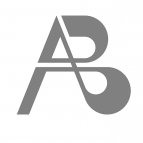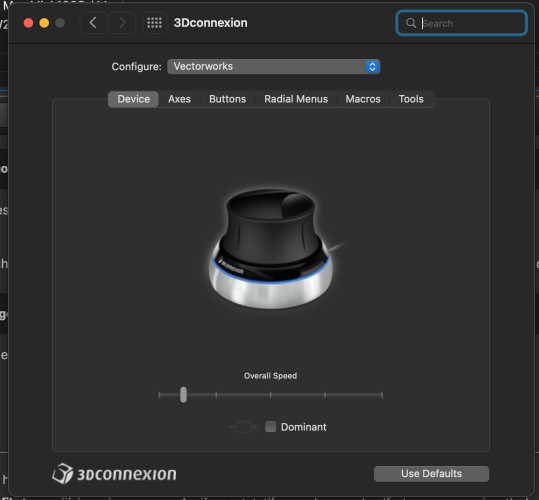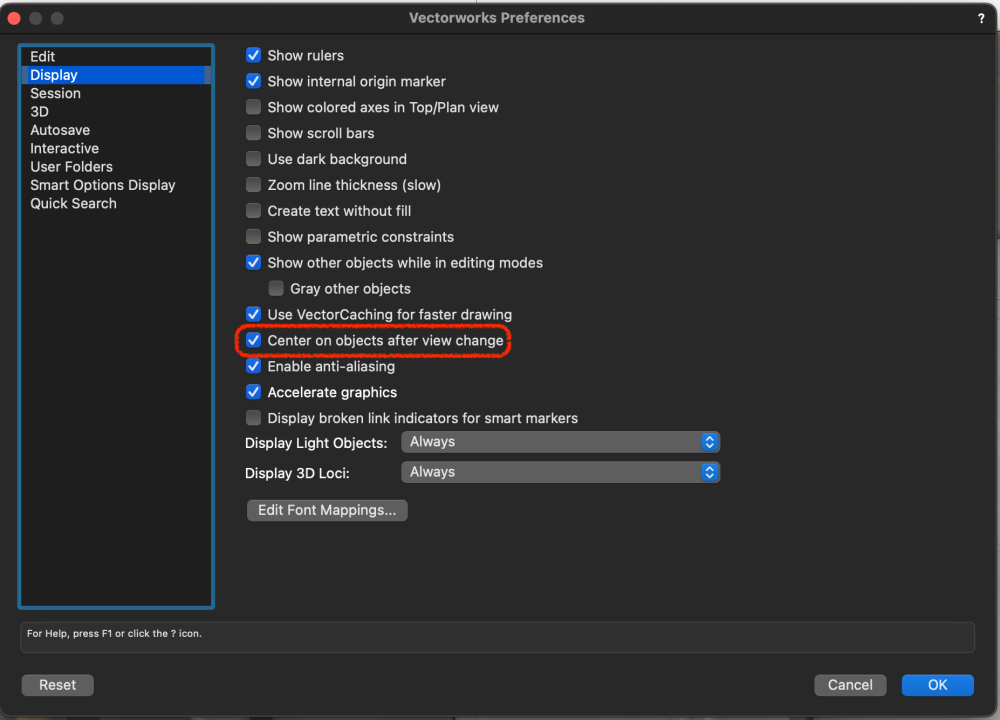-
Posts
3,173 -
Joined
-
Last visited
Content Type
Profiles
Forums
Events
Articles
Marionette
Store
Posts posted by Andy Broomell
-
-
- Popular Post
- Popular Post
Technically Vectorworks has "Design Layers" and "Sheet Layers." Both of these together comprise "Layers" in Vectorworks; at any given moment, you have one Active Layer that you are drawing on, and this can be either a Design Layer or a Sheet Layer. That's why Design Layers and Sheet Layers are in the same dropdown list in the view bar. They're indeed different types of Layers.
That being said, while your initial comment that "Sheets are not layers" is inherently incorrect, it does stem from a valid criticism of the terminology in the program. "Design Layers" are often colloquially called "Layers" as shorthand, so it's then confusing when a user hears "Sheet Layer." Shortening the latter to "Sheets" makes a lot of sense. You're not the first to request that these names be reexamined, and I'd back up that request as well. As Tai points out, the change would have to happen first in the UI of the software itself, and then the tutorials could be updated to stay consistent with the UI. But as it stands, the tutorials are currently correct in saying "Sheet Layers."
-
 5
5
-
It’s under File > Document Settings > Document Preferences, Dimension tab. Note that this is document-specific, so you may want to change this in your template file and re-save your template.
-
 1
1
-
-
I've had this setting mysteriously turn itself on a couple times, so who knows 😅
-
 1
1
-
-
It seems as though "Unified View" is turned off, which is something that you'd typically only want for legacy/outdated workflows.
Which version of Vectorworks are you using?
If in 2022 or 2023, go to File > Document Settings > Document Preferences, go to the "Legacy 2D" tab, and make sure "Turn off unified view" is unchecked. You can also then try unchecking the first "Enable legacy 2D features" option, though it might not let you if there are already Screen Plane objects in the document. But the unified view thing is the important part.
-
 1
1
-
-
Unless it's change in recent years, I believe it always uses the first Line Type from the current file's Resource Manager, that is, alphabetically. There have been requests over the years to be able to specifically choose which linetype it defaults to, but nothing has been implemented.
One workaround is to simply re-name the linetype you typically want so that it falls first in line (such as "1. Medium Dash"), though I realize this may not practical for everyone depending on naming standards and/or resource sharing.
-
Model > Add Solids
-
Commenting in order to follow this thread and hear what other folks say.
I'm assuming you've tried selecting all the objects and doing Modify > Convert > Convert to Generic Solids, and/or making them a Solid Addition? I've had mixed success with this for imported items...
-
There have been many wishes over the years to address this sort of situation, where a viewport could look at a particular object as opposed to dealing with Class/Layer Visibilities to isolate something. Typically the request is to add the ability for a viewport to "look at" a particular Symbol definition instead of at a Design Layer. However, this has not been implemented, so in the mean time there are a few other ways to approach it:
The way you're doing it works fine, but another similar approach would be to make a separate Design Layer for each item, instead of separate Classes. That way, Design Layers are used solely for visibilities, and you don't have to worry about Class Attributes, nested classes, how classes relate to Auto-Hybrids, etc. You'd still be able to use Classes if/as necessary, but it wouldn't be tied into the idea of isolating items for drafting. One drawback in this workflow is that stacking order becomes a slight pain (if you care about 2D representations in Top/Plan and have lots of overlapping objects). Stacking order in this scenario can only be addressed by rearranging Design Layers. That being said, for 3D-centric workflows, this Design Layer approach might be slightly friendlier than doing it with Classes.
Another approach some folks use is to have one master Design Layer with all items assembled. Each item is a Symbol. That way you can place another instance of each Symbol, each on its own separate Design Layer, for the purpose of isolating that item for drafting. Since they're all symbols, when you update an item in the context of the combined master Design Layer, it ALSO updates on the isolated Design Layer, and vice verse. This workflow is advantageous in workflows where units might be "moving around" in the master Design Layer as the design evolves (such as stage scenery), since problems arise when you move objects after creating viewports. In this workflow, since viewports are looking at separate isolated Symbol instances which don't move, this problem is avoided. This workflow is also useful when each item might have multiple instances duplicated throughout a design, but only needs to be drafted once.
I don't believe there's currently a way to isolate objects in a viewport bases on Object Name, but that would be an interesting suggestion to tie into future improvements as mentioned above (for example, perhaps you could create a Viewport from scratch and get a list of Symbol Names and a list of Named Objects, then choose one of these as the basis for the viewport). Some day...
Hope this helps. Others might have additional workflow ideas.
-
 3
3
-
-
Confusingly, there's both a "Set Working Plane" command and a "Set Working Plane" tool which are two different but similar things.
Regardless, the contextual option proposed in the original post is a smart idea.
-
 1
1
-
-
Just echoing what Pat said - it seems to have to do with it being a Lighting Device for some reason. There's nothing wrong with your render settings or sweep settings.
While I have no idea why it's doing that, if you'd like a workaround, just edit the 3D component of the Symbol, navigate to the knobs and select them, then do Modify > Convert > Convert to Generic Solids. Hopefully this helps.
-
Clicking that Modify button shouldn't be changing the view. When I click it the view doesn't change.
Has this always been the case for you or has the behavior recently changed? What about trying it in different files?
-
Which Modify button?
-
@unearthed - what Design Layer scale are you using?
-
51 minutes ago, Tom W. said:
Andy what exactly does enabling 'Dominant' do? I've never noticed any difference one way or the other...
I'm not sure either...
-
8 minutes ago, line-weight said:
This just doesn't really work for projects where output drawings might range in scale from 1:5 to 1:100.
You could still choose one of the most common scales and gain some advantage.
12 minutes ago, line-weight said:I set all my design layers to 1:1 because otherwise I have problems using my 3d navigator device.
You might try turning down the "overall speed" within 3Dconnexion settings. For example, I default to 1/4"=1'-0" scale for my design layers, and have my overall speed setting like this:
-
 1
1
-
-
I think most of your hunches are correct. The precise positions of the little handles in the OIP beam angle widget don't mean anything, they're just a way to interactively adjust the Spread & Beam fields, which are the only two values which have an affect.
"Smooth" & "Realistic" falloff are just names that someone came up with, sort of like presets. I'm sure each correlates to some underlying value that we don't have direct control of, but regardless, all three options are just varying "amounts" of falloff.
The "look to" handle on the Light object itself doesn't control anything other than the general direction of the light.
I too have issues with adjusting Lights directly in the drawing window. The interface for working with Lights is indeed generally awful and antiquated. As far as I recall, Lights haven't been touched or improved in my 15 years of using Vectorworks. The rendering output is fine, but it's a pain to get them set up since we're dealing with an ancient GUI.
-
 4
4
-
-
Crazy - I never noticed that you DO get the option when double-clicking Flipped Symbols.
I agree it should be available when double clicking any Symbol in the drawing.
-
 1
1
-
-
VE-103821
-
- Popular Post
- Popular Post
Sometimes we use Vectorworks to ‘present’ a design to someone, whether it be a colleague, boss, head designer, design team, a group on Zoom, etc. When presenting, we’re mainly just navigating our working file, pointing out things with the cursor, discussing elements, maybe selecting objects to see OIP properties, etc. But we’re not ‘working’ or doing any heavy editing. So the problem is that there’s potentially a lot of distracting gak on the screen that isn’t needed in a presentational context, and which sometimes pulls attention away from the focus of discussing the design. It’d be great to be able to quickly switch to a temporary “Presentation Mode” whenever you know you’re only going to be using Vectorworks in this simplified way while others are watching.
I suggest that under the Window menu there could be a new option to toggle “Presentation Mode” which would automatically turn on and off certain existing settings with one quick command. This would be customizable, so there would need to be a place to set up which settings you want to be affected. Under Presentation Mode Settings there would be checkboxes for the following:
☐ Suppress all auto save pop-ups.
☐ If using full-screen cursor, switch to simple pointer cursor.
☐ Hide Light glyphs, green constraints, red unlinked indicators, loci, and other various glyphs.
☐ Hide red viewport “out-of-date” borders.
☐ Turn off snap indicators, smart cursor cues, acquisition hints, red smart points, etc.
☐ Turn off pre-selection highlighting and other highlighting, keeping only selection highlighting. (This one is where the idea started for me. I want to point at something with the cursor and not see giant orange pre-selection boxes popping up all over the place.)
☐ Turn off "Use Sound."
☐ Suspend snapping
☐ Hide enabled palettes (that is, the setting that already exists in Window menu).
☐ Disable Smart Options Display’s idle trigger.
☐ Switch Floating Data Bar to be only show on Tab (if not already).
☐ Deselect all objects across all Layers (for example, when you’re flipping through Sheet Layers there wouldn’t be viewports already highlighted from previous work.)
Upon engaging Presentation mode, all of the checked items would be affected. Upon disengaging Presentation mode, settings would return to the same as they were before (I suppose with the exception of object selection state).
When in Presentation mode, perhaps there’s a colored border around the screen to be clear that you’re in a special context, or maybe a bit of text in the status bar at the bottom.
Maybe Presentation Mode is actually a Quick Pref button so you can quickly pop in and out of it (for example, perhaps in the middle of the presentation you need to do some real editing, so you toggle it off, make the change, then toggle it back on.)
-
 6
6
-
Unfortunately, yes, there's been an issue for a number of years where having Image Effects checked for a viewport causes the issue you describe, but seemingly only when the viewport bounding box changes sizes. I have a bug report filed for this with repeatable steps, so hopefully a fix will make it into a SP at some point.
For now, you have uncheck Image Effects, render again, then re-check Image Effects.
-
 2
2
-
-
Are you using Image Effects on the viewport?
-
 1
1
-
-
Yes, along with switching between a few other builds (and betas of future builds), but that didn’t seem to affect anything. I think today’s file is particularly problematic so I attached it to a bug report.
-
 2
2
-
-
I think this thread cursed me. After saying I hadn't experienced the issue in 2023, I've now encountered it 4 times today.
-
 2
2
-
-






Projectors going dark after inserting lighting fixtures
in Troubleshooting
Posted
I can't believe we still don't have manual control over the Default Light. The current behavior is unintuitive.